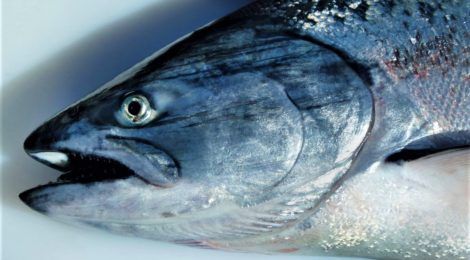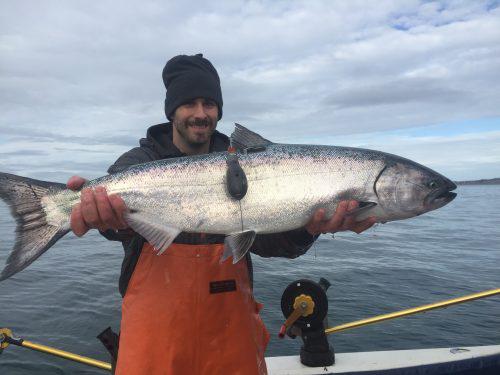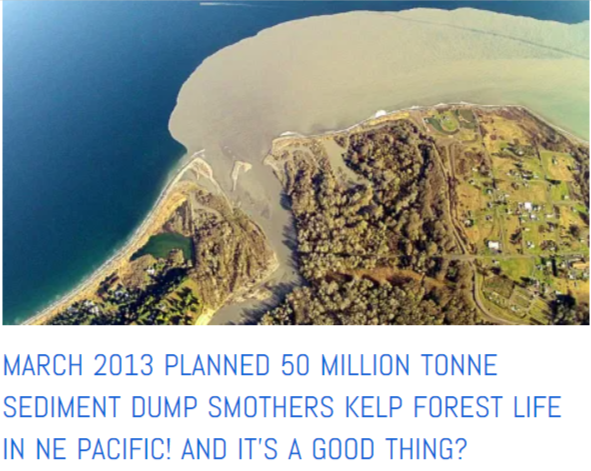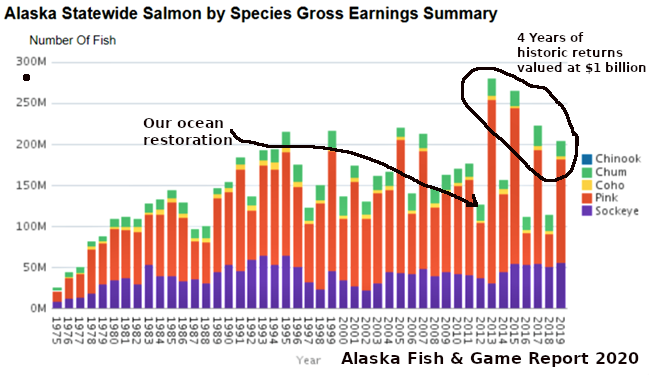
King Salmon Study Proves Their Demise Is Due To Starving At Sea
Newly Published Scientific Report Declares Dangers During Freshwater Life Of Salmon Is Nothing When Compared To The Collapse of Their Ocean Pastures
This exhaustive research used decades of historical data and new state of the art tagging data to reveal that King Salmon survival at sea has been reduced to barely 1%
When counting how many adult salmon return to their native streams to spawn, no difference is seen between the most developed streams and perfectly pristine wilderness streams.
Salmon have been tragically starving at sea as entrenched salmon management still ignores the all-important ocean life of salmon where they put of 95% of their growth.
Here you can learn how we the real science supports the way that we can immediately BRING BACK THE FISH
This definitive study has created a raging controversy with traditional salmon management and advocacy groups lining up to condemn the findings that their exclusive focus on the freshwater life of salmon remains appropriate. They complain that their decades of fomenting anger and angst aimed at dams or other freshwater issues is just plain wrong.
A Fisherman’s Birds Nest Tangled Controversy
The research paper has been stagnating and trapped by belligerent peers who created a ‘birds nest tangle’ of so-called academic peer review for over two years. Finally, it has now, 30 October 2020, been published by the Journal Fish and Fisheries. The reason for the delay becomes clear as it creates dire implications for the managers and fishermen of the commercial troll fishery off the coast of Alaska, Canada, Washington, Oregon, and California. Those fisheries depend heavily on the Chinooks, King Salmon, that spawn in rivers and streams of Canada and the Pacific Northwest.
Given its long, history of pursuing the Southern Kings trollers contend they are entitled to the lions share of the fish that pass through and graze upon Alaska ocean pastures. Harvests have been collapsing as Chinook stocks falter in the Columbia River watershed. That collapse had been long explained as a problem only to the heavily developed Pacific Northwest rivers and especially the impacts of their extensive dams. But the collapse has been steadily showing up in more northern waters.

King Salmon with tag that allows tracking the fish over thousands of miles of its migratory life on North East Pacific ocean pastures.
British Columbia salmon scientist extraordinaire and emeritus Dr. David Welch and his associates at Kintama Research Services have shown conclusively that Alaska’s King salmon rivers wild, untrammeled, with no dams and very little human habitation are now producing worse than those of southern regions like the Columbia that are dominated and thought to be devasted by dams, agriculture, industry, freeways and big cities.
But the decline in productivity and the King and other salmon crisis is now clearly seen to have little if anything to do with the terrestrial landscape. Instead, the problem appears to be that salmon runs are limited at this time by the collapse of the primary productivity of their ocean pastures.
God Save The King
Commonly called king salmon in Alaska and prized as the largest of the salmon species, Chinooks in the Lower 48 have been the subject of acrimonious debate for decades because of the now shown to be mistaken belief, that their numbers have been decimated by hydroelectric dams on the Columbia and its tributaries.
The Kitama team showed that the harvest of different Chinook populations returning to the Columbia River was large and increasing over time. As a result, the PIT-tag system used by Columbia River salmon managers was more about measuring what escaped from the fishery and was not just measuring the survival influenced by the dams as originally thought.
No Dam Way
Welch emailed that he and his colleagues are not arguing the dams have no effect on Columbia salmon numbers, but their data would indicate the damage might be far less than long believed.
“The team’s results suggest that the dams’ influence could be minor, and they aren’t a major factor affecting salmon productivity,” concluded Scientia Global, a research publication for scientists and policymakers who studied the study.
Environmentalists, fishermen and Indian tribes have long been advocating for the removal of the dams because of the salmon management problems they create. It has been called the battle of Fish versus Power. Almost all those groups reacted angrily earlier this year when a federal study rejected removing four dams on the Snake River, a major Columbia tributary, in what the Associated Press dutifully inflamed by describing it as “a last-ditch effort to save more than a dozen species of threatened or endangered salmon.”

In 2013 removal of the Elwha River dam in Washington state cost $325 million. It sent 50+ million tonnes of noxious sediment into the Pacific smothering marine life over a vast area. Now it is shown to have been a dubious exercise without scientific merit. Native groups, environmental groups, and contractors were enriched. In 2020 only a few salmon have returned to the river below the dam that was scoured into oblivion, none have shown up in the river above the former dam location.
The federal study concluded removal of the dams would destabilize the regional power grid, force an increase in greenhouse gas emissions and more than double the risk of regional power outages in five million homes scattered across more than a half-dozen Western U.S. states.
While a high-profile debate about the dams’ effect on salmon has raged for years, the far wider decline of Chinook salmon stocks from Alaska south to California has been given virtually no attention by the groups ranting for the removal of dams.
Poor “ocean survival” has often been cited in years when Kings returned in low numbers to the Kenai, Susitna, Copper and other well-known watersheds in Alaska, but prior to the Kintama study, no one had gone looking to find a pattern that might define the true ocean pasture collapse reason for the decline. In Alaska, the Chinook decline has been largely overshadowed by larger catches of pink, chum and sockeye salmon that fishermen refocused their efforts upon as King Salmon steadily disappeared.
As the Kitama scientists write, “the historical pattern of declines in salmon abundance (steeper in the south, less so in the north) were originally assumed to reflect a freshwater (human-driven) cause because of the greater degree of freshwater habitat modification in the more populous southern regions.”
But that is not what they found. Instead, the data pointed to a steady decline in SAR for Chinook everywhere along the coast since a regime change in the late 1970s shifted the waters of the North Pacific from a generally cooler to a generally warmer state.
Among the Alaska stocks showing lower survival levels than the lower 48 are five in Southeast Alaska included in the study. The Kenai River – the most famous king salmon river in the state and home to the 97-pound, 4-ounce world record catch on rod and reel – was not included in the study, but the king struggles there are well known. The river failed to meet its minimum spawning goal in 2019 and again this year despite strict limitations imposed on sport and commercial fishermen to minimize harvests.
The Kintama study facts show dogmatic salmon management does not appear to bode well for King salmon fisheries.
“At the broadest level, the major implication of our results is that most of the salmon conservation problem is determined in the ocean by common processes,” the authors wrote.
“Attempts to improve survival at sea by addressing region-specific issues such as freshwater habitat degradation or salmon aquaculture in coastal zones are therefore unlikely to be successful.”
The study scientists are calling for a ‘joint systematic effort by major funding agencies’ to attempt to do something to prevent the final and total collapse of the Chinook King Salmon survival in the ocean.
The Better, Faster, Cheaper Natural Way To Bring Back The Fish
As it is now again made abundantly clear the crisis of fish in the oceans is not merely one of human abuses by the usual suspects. The first and greatest cause of ocean fish decline is the collapse of ocean pasture productivity. It’s not rocket science. We have known how vital it is to take care of our pastures on land for ten thousand years, but most refuse to consider offering the oceans the same loving stewardship that comes with being good shepherds.
Sometimes a single picture is all that is needed to confirm a scientific fact. What happens when the ocean salmon pastures are restored to historic levels of health and abundance. The source of that ocean miracle was our ‘dust cheap’ efforts to restore North Pacific Salmon pastures.
Looking at this chart published in early 2020 by the Alaska Department of Fish and Game with my circles and arrows added to help tell the story. In this public private partnership project operated by my company with partners from the First Nations, the Province of British Columbia, and the Federal Government of Canada we targeted the Pink salmon and their vital ocean nursery pasture. Pink salmon have the shortest, 2 year, life-cycle of the five species of Pacific Salmon native to the Eastern Pacific. They hatch in rivers in the winter and when the spring thaw and floods arrive the baby Pink salmon, smolts, are swept out to sea. There they have less than two years to grow to maturity before their spawning instinct will see them return to the very rivers and streams where they were hatched. Pink salmon display their two-year cycle with a large return during odd-numbered years and a small return during even-numbered years.
In this wonderful graphic of the Alaska salmon caught over the past 50 years, one sees immediately that something wonderful happened to benefit the Pink Salmon. But not just the Pinks, the number of Chum and Sockeye salmon were also beneficially sustained. In perfect timing to our work to restore the Pink salmon pasture during the summer of 2012, it is apparent that our hypothesis is proven. The expected catch of Pink Salmon in 2013 was provided by countless salmon experts and managers to be a good catch of 50 million fish. But the catch turned out to 224 million Pinks, that’s 4.5 times the official prediction! The largest catch in all of history.
We now have a much better understanding of the vital ocean pastures of the King Salmon, and all their kin. It is immediately feasible to take on the role of good shepherds to all of the salmon, tend to, replenish and restore their ocean pastures to historic levels of health and abundance. As we do so the fish will immediately return to historic numbers in every river and stream from California to Alaska.
Join us.









